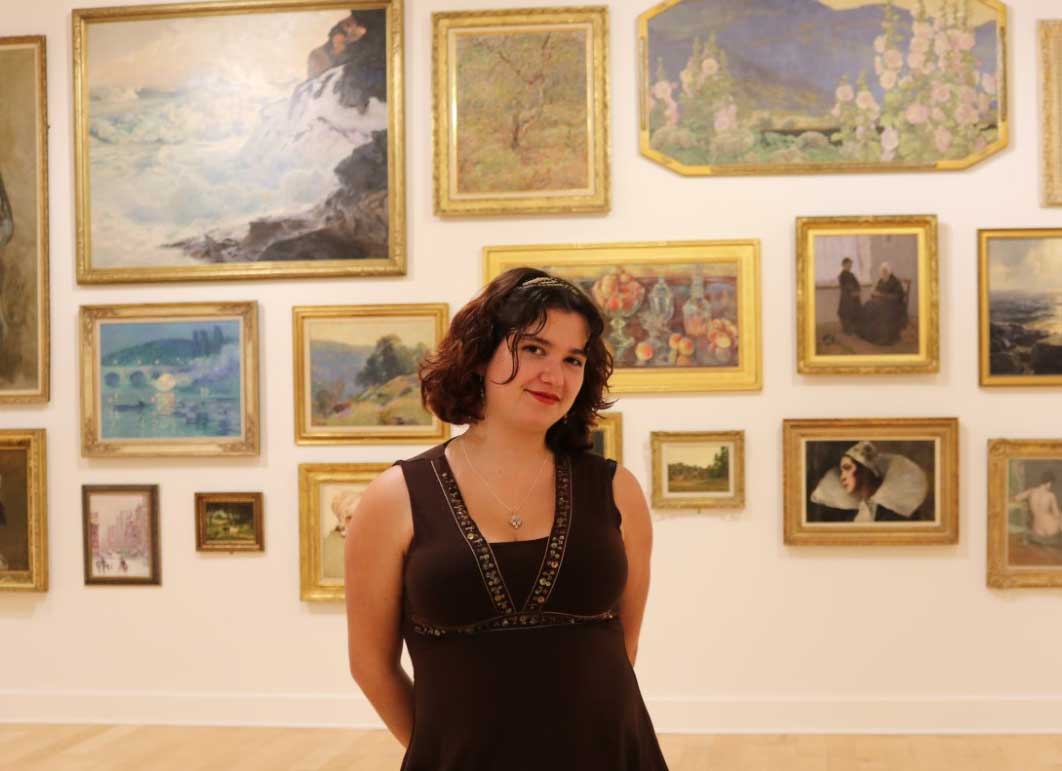By Laura Wilkinson

Inspired by an introductory course in modern Latinx art due to their personal connection to the culture, Corina Silverstein ’25 is helping expand the collection of Chicanx and Latinx art at the El Paso Museum of Art (EPMA), with a focus on the representation of women and queer artists. Silverstein’s work is supported by Scripps’ Mary W. Johnson and J. Stanley Johnson Student Research Award, established in 1995 to support student summer research projects.
Although Chicanx and Latinx groups make up nearly 19 percent of the United States population, Chicanx and Latinx artists are grievously underrepresented in public spheres, specifically within traditional art spaces and institutions.
“In most exhibition spaces, museums do not display, curate, or collect Chicanx or Latinx art— especially women of color and queer artists,” says Silverstein. “I wanted to learn and research in a museum that embeds Chicanx and Latinx voices and culture within the institution as well as displays the intersectional identities Chicanxs and Latinxs hold.”
El Paso’s Chicanx history and culture made EPMA an obvious choice for Silverstein’s research. “Commonly referred to as El Chuco for the origin of the Pachuco subculture, El Paso has a long history of rich Chicanx and borderland culture that represents the predominant Mexican-American community,” they explain.
Provided with a checklist of potential pieces to include in the exhibit by EPMA Assistant Curator Claudia Preza, Silverstein has identified common themes within the works to make informed suggestions on what to include in the exhibit.
“I researched around 60 pieces that contained Latinx and Chicanx women and identified the following themes: stereotypical forms of representation of Latinx women such as women only depicted as a mother, daughter, or saintly figure; the male gaze and objectification of Latinx women; art addressing violence against women and their resilience; artistic exploration of identity; and Chicanx/Latinx folktales and legends,” Silverstein says. “I helped suggest pieces that would be removed from the checklist to better prioritize Latinx women artists agency in articulating their own narrative.”
In addition to researching artistic themes, Silverstein created a survey to be sent to the museum’s Contemporary Art Collection 1960–Present artists regarding artists’ racial, ethnic, gender, and LGBTQ+ identities.
“This data analysis will help EPMA ensure that all voices, backgrounds, and identities are represented within the museum and that the artists’ have full agency of their self-described identities,” they explain. “This will help in the future acquisition of pieces that fill possible gaps of representation within the museum.”
With guidance from Rosalía Romero, assistant professor of art history at Pomona College, Silverstein has been able to fully immerse themselves in research, allowing them to pursue their passion for art history and queer Chicanx artists both in and outside of the museum.
“Corina’s summer research will bring to light the important contributions of Chicanx and Latinx artists to American art in the US and across its border,” says Romero. “The internship at the El Paso Museum of Art will not only offer them an enriching experience in which to learn curatorial practice, but it is also an incredible opportunity for them to generate dialogue about the arts in a dynamic, multicultural city.”
Through statistical analyses of current represented identities as well as deconstructions of previous Eurocentric, misogynistic, and sexist stereotypes typically projected onto Latinx and Chicanx women, Silverstein is working to change the public perception of Latinx and Chicanx women artists. Their suggestions for pieces and artists will inform not only the upcoming exhibition at EPMA, but also for the museum’s permanent collection.
“This work goes beyond a summer’s worth of research,” they say. “My dedication to Chicanx/Latinx art will follow throughout college, as a piece of my heart, soul, and mind will always be dedicated to the borderlands and the vivid arts cultures present within the community.”

